Related Research Articles

Nepal is a multi-ethnic, multiracial, multicultural, multi-religious, and multilingual country. The most spoken language is Nepali followed by several other ethnic languages.

The Kingdom of Nepal was a Hindu kingdom in South Asia, formed in 1768 by the expansion of the Gorkha Kingdom, which lasted until 2008 when the kingdom became the Federal Democratic Republic of Nepal. It was also known as the Gorkha Empire, or sometimes Asal Hindustan. Founded by King Prithvi Narayan Shah, a Gorkha monarch who claimed to be of Khas Thakuri origin, it existed for 240 years until the abolition of the Nepalese monarchy in 2008. During this period, Nepal was formally under the rule of the Shah dynasty, which exercised varying degrees of power during the kingdom's existence.

The Nepali Congress is the oldest democratic socialist political party in Nepal and the largest party in the country. The party has 870,106 members as of the party's 14th general convention in December 2021 making them the largest party by membership in Nepal. Currently the party has started online membership since the emergence of youth leaders in vital post to bring youths into the party.
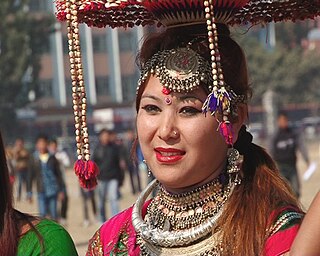
The Tharu people are an ethnic group indigenous to the Terai in southern Nepal and northern India. They speak Tharu languages. They are recognized as an official nationality by the Government of Nepal. In the Indian Terai, they live foremost in Uttarakhand, Uttar Pradesh and Bihar. The Government of India recognizes the Tharu people as a scheduled Indian tribe.

Bhimsen Thapa was a Nepalese statesman who served as the Mukhtiyar and de facto ruler of Nepal from 1806 to 1837. He is widely known as the longest-serving prime minister of Nepal and was inducted into the "National heroes of Nepal" by King Mahendra Bir Bikram Shah.

Jung Bahadur Kunwar Ranaji, Born to the Kunwar family, Jung Bahadur was a Khas Chhetri ruler of Nepal and founder of the Rana Regime in Nepal. Jung Bahadur took control of the government after killing an alleged usurper Gagan Singh, who was accused of plotting with the junior queen in 1846 to become prime minister by putting the queen's son on the throne. His original name was Bir Narsingh Kunwar but he was commonly known as Jang Bahadur, a name given to him by his maternal uncle Mathabar Singh Thapa. Mathabar Singh Thapa used to call Jang Bahadur Jangay for his boldness.

Chhetri, historically called Kshettriya or Kshetriya or Khas are Nepali speaking Rajputs of Khas community, some of whom trace their origin to migration from medieval India. Chhetri was a caste of administrators, governor and military elites in the medieval Khas Kingdom and Gorkha Kingdom. The nobility of the Gorkha Kingdom mainly originated from Chhetri families. They also had a strong presence in civil administration affairs. The bulk of prime ministers of Nepal before the democratization of Nepal belonged to this caste as a result of the old Gorkhali aristocracy. Gorkha-based aristocratic Chhetri families included the Pande dynasty, the Basnyat dynasty, the Kunwar family, and the Thapa dynasty,.

The prime minister of Nepal is the head of government of Nepal. Together with their Council of Ministers, the prime minister exercises executive power in the country.
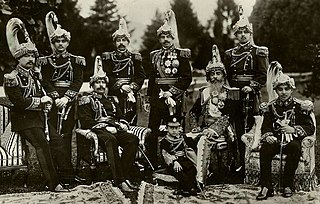
The Rana dynasty were a Chhetri dynasty that imposed authoritarianism in the Kingdom of Nepal from 1846 until 1951, reducing the Shah monarch to a figurehead and making the Prime Minister and other government positions held by the Ranas hereditary. They are Kshatriya, whose ancestors were descended from the Ranas of Udaipur, Rajasthan, India. The Rana dynasty is historically known for their iron-fisted rule. This changed after the Revolution of 1951 with the promulgation of a new constitution, when power shifted back to the monarchy of King Tribhuvan.
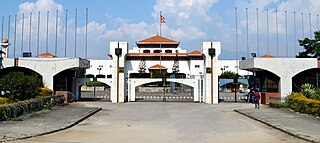
The Nepalese democracy movement was the combination of a series of political initiatives and movements from the 20th century to 2008 that advocated the establishment of representative democracy, a multi-party political system and the abolition of monarchy in Nepal. It has seen three major movements, the Revolution of 1951, Jana Andolan and Loktantra Andolan which ultimately abolished the Shah monarchy, transitioned Nepal towards a republic and reintroduced multi-party bicameral democracy.
The Nepalese caste system was the traditional system of social stratification of Nepal. The Nepalese caste system broadly borrows the classical Hindu Chaturvarnashram model, consisting of four broad social classes or varna: Brahmin, Kshatriya, Vaishya, Sudra.

Nepal Sambat, also spelled as Nepala Sambata, is the lunisolar calendar used by Nepali of Nepal. The calendar era began on 20 October 879 AD, with 1143 in Nepal Sambat corresponding to the year 2022–2023 AD. Nepal Sambat appeared on coins, stone and copper plate inscriptions, royal decrees, chronicles, Hindu and Buddhist manuscripts, legal documents and correspondence.

The Government of Nepal is the federal executive authority of Nepal. Prior to the abolition of the Nepali monarchy in 2006, it was officially known as His Majesty's Government.

The Election Commission is a constitutional body responsible for conducting and monitoring elections, as well as registering parties and candidates and reporting election outcomes, in Nepal. It was born out of the 1950 revolution in Nepal, and was established in law in 1951, although it has been changed somewhat by law over time. It has six members who serve for six-year terms, as established by the Constitution of Nepal. During the Constituent Assembly elections in 2008, it was criticized for not fully upholding its duties, but was acknowledged to have managed the elections well nonetheless.

The revolution of 1951 in Nepal, also referred to as Sat Salko Kranti, was a political movement against the direct rule by the Rana dynasty of Nepal which had lasted for 104 years. It marks the beginning of the political awakening and democratic movements in Nepal, and resulted in immediate abolition of the institutionalized hereditary Prime Minister system in Nepal.

Inspection Tour System of Nepal known as Daudaha( Devnagri:दौडाहा) was a supervision system mainly implemented during Rana era between 1846 and 1950. The significance of Daudaha tour was to travel and check into all aspects of government activities and investigate certain conditions within a certain district. The main purpose of Daudaha was to maintain law-and-order in farthest unreached districts of the Nepal along with investigating if the implication of Muluki Ain was properly done or not. Daudaha trips were on average 3 to 4 months long.
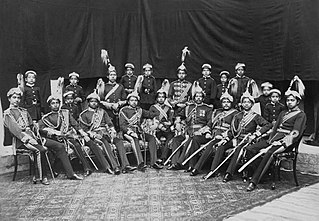
The Rolls of Succession in Rana or Rollkram Pratha was the official order of succession of the Rana Dynasty of Nepal. This order was regulated not only through descent, but also by lineage. It was established by Jung Bahadur Rana as a formal ranking of all of his descendants in relation to their hereditary rights to the office of prime minister, with no legal mechanism for changing the government.
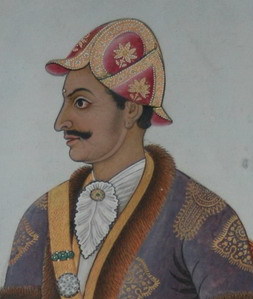
Mukhtiyar was the position of head of executive of Kingdom of Nepal between 1806 and 1843. It was equivalent to Prime Minister of Nepal. There were 7 Mukhtiyars appointed between 1806 and 1843.
References
- 1 2 Brown, T. Louise (1 November 2002). The Challenge to Democracy in Nepal. Routledge. pp. 6–. ISBN 978-1-134-88533-6.
- 1 2 Joshi, Bhuwan Lal; Rose, Leo E. (1966). Democratic Innovations in Nepal: A Case Study of Political Acculturation. University of California Press. pp. 27–. GGKEY:5N30S3HU9BC.